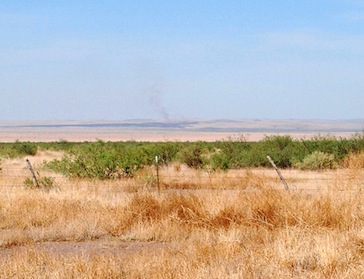After enduring the record-setting heat and dry conditions of 2011, drought-weary Texans are being greeted with forecasts of more of the same for the new year.
The U.S. Drought Monitor, a government-university consortium, issued a report Tuesday with this alert for the central region including Texas:
Following a relatively wet finish to 2011, the return of warm, dry weather to the nation’s southern tier could be suggestive of an increasingly La Niña-driven atmospheric regime. If true, a return to dryness would not be favorable for the south-central U.S., where long-term drought retains a grip. For example, 80 percent of the rangeland and pastures in Texas remain in very poor to poor condition, according to an early-January report by the U.S. Department of Agriculture.
On Thursday, the National Weather Service issued its latest Seasonal Drought Outlook, for the period from Jan. 5 through March 31, which featured a map showing persistence of drought conditions across virtually all of Texas, with “some improvement” expected in a small sliver of the northeast corner of the state and “drought development” in four remaining and smaller areas in North Texas and the Panhandle.
A report by the National Weather Service Climate Prediction Center, also issued [PDF] Thursday, cautioned that the La Niña weather pattern, generally blamed for 2011’s brutal drought conditions in Texas, was expected to last into the spring.
The center’s report said, “the latest observations, combined with model forecasts, suggest that La Niña will be of weak-to-moderate strength this winter, and will continue thereafter as a weak event until it likely dissipates sometime between March and May.”
Reuters, in an article discussing the La Niña report’s economic implications, noted that that weather pattern “can last for several years.”
The Austin American-Statesman had an article on New Year’s Day that portrayed Central Texans’ experience of the exceptionally hot and dry conditions last year that set records in many parts of the state:
Setting another climate record in a year that has toppled many Austin and state records that contain the words “heat” and “dry,” 2011 was the city’s hottest year on record, with an average temperature of 72.6 degrees beating 2006’s record of 71.7 degrees.
During 2011 farmers and ranchers lost billions in crops and livestock, Central Texas’s main reservoirs dropped to the lowest levels seen in almost a half-century, and the state suffered through its costliest wildfire in September in Bastrop, all at the hands of a crippling drought.
The drought’s widespread impact has led many to call 2011 the worst single year of drought recorded in Texas. While the state’s 25 million people are sure to be glad to put that record in the past, meteorologists say the drought isn’t going anywhere.
The usually wet springtime was one of Central Texas’ driest, leading to a 5.8-inch rainfall deficit from March to May at Camp Mabry, according to National Weather Service data. Typically, the sun warms the ground, still cool and soggy from the wet season, but this year the dry soil allowed the sun to bake the ground and warm up the atmosphere earlier than usual, said Victor Murphy, the weather service’s southern region climate service manager.
News from the Beaumont area this week was a reminder that wildfires, one of the 2011 drought’s most critical impacts, remain a threat, albeit a smaller one at the moment. The Associated Press reported on Monday that fires had broken out in areas of the “bone-dry” marshlands of Southeast Texas.
The AP article said the wind-driven fires destroyed vegetation across several hundred rural acres, prompting evacuation of several homes near one big blaze.
The Houston Chronicle reported on Friday that “fog and smoke from lingering wildfires” had prompted a 79-vehicle accident near Port Arthur early Thursday morning, and that 54 people were sent to hospitals.
The Texas Forest Service’s latest wildfire update on Thursday noted that fire danger was assessed as low to moderate in most of the state, with burn bans remaining in effect for 116 of 254 counties.
Meanwhile, the AP reported on Thursday that Gov. Rick Perry had renewed his disaster proclamation for the Texas drought, which was first issued a year ago:
Perry’s proclamation says all counties in the state are plagued by extreme drought conditions and are vulnerable to wildfires.
Also Thursday, the Texas Farm Bureau said its members granted more than $1.4 million to help Texas volunteer fire departments in the wildfire fight.
– Bill Dawson

